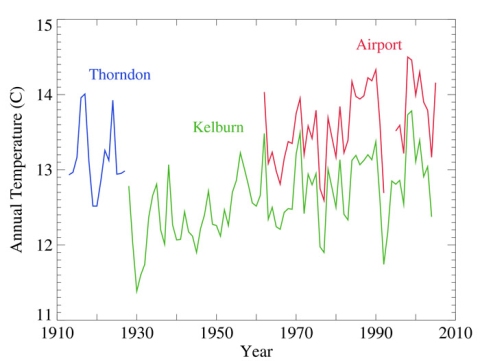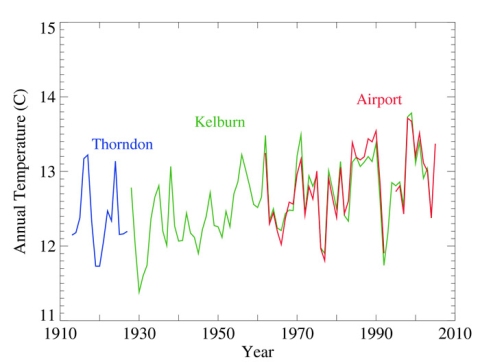In Wellington early temperature measurements were made at a site in Thorndon, but the site was relocated in 1928 to Kelburn. The Kelburn site is colder because it is about 120m higher than the Thorndon site. This illustrates why we sometimes need to adjust climate data.
The temperature in Wellington depends on where it is measured
Temperature measurements have been made in the Wellington City area since 1862, but the measurement site has been moved several times. It is well known that some parts of Wellington are colder than others, so the ‘Wellington’ temperature depends on where it is measured.

This graph shows annual temperatures at three Wellington sites: Thorndon (3 metres above sea level), Kelburn (125 metres above sea level), and Wellington Airport (4 metres above sea level), as recorded in the NIWA Climate Database.
In Wellington, the well-understood physics of a temperature decrease with height (the “lapse-rate” effect) is the primary cause of the differences. Kelburn is about 120m higher in altitude than Thorndon or Wellington Airport.
Comparing between sites shows the need to adjust
Since the 1960s, we have measurements from both Kelburn and Wellington Airport. This shows clearly how both sites fluctuate up and down in unison from year to year – the trend is similar even though the absolute temperature reading is different.
Thus, if one measurement station is closed (or data are missing for a period), it is acceptable to replace it with another nearby site provided an adjustment is made to account for the average temperature difference between the sites. These adjustments are based on accepted international practice.
How do climate scientists make adjustments?
Climate scientists compare and calculate the differences between climate stations.

This graph shows the annual temperatures at the same three sites, but with Thorndon and Wellington Airport adjusted to match the Kelburn record.
Comparing Wellington Airport and Kelburn
Where there is an overlap in time between two records (such as Wellington Airport and Kelburn), it is a simple matter to calculate the average offset and adjust one site relative to the other. Wellington Airport is +0.79°C warmer than Kelburn, which matches well with measurements in many parts of the world for how rapidly temperature decreases with altitude.
Comparing Thorndon and Kelburn
Thorndon overlapped with Kelburn for just 29 days. For this illustration, we have applied the same offset to Thorndon as was calculated for the Airport. In fact, for the NIWA seven-station temperature series we use a more sophisticated technique comparing records from several sites across the changeover period.
See our technical notes for more detail.
What does all this mean in the end?
The final “adjusted” temperature curve can be used to draw inferences about Wellington temperature change over the 20th century. The raw temperature records must be adjusted when sites are moved to different locations around the Wellington area.
Over the 100-year period from 1909 to 2009, the least squares linear trend for the composite 'Wellington' annual temperature record is +0.79 ºC, with an associated 95% confidence interval of +0.49 ºC to +1.10 ºC.
